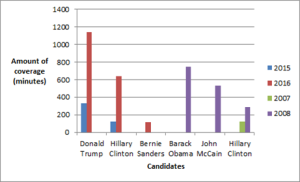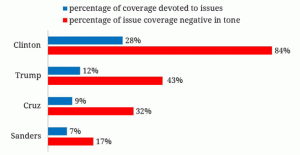Case Study #14: Bernie Sanders’ Media Blackout
By Melissa White and Erin Relland, 2017
Background
Leading up to the 2016 US presidential election, Hillary Clinton seemed to be the prohibitive favourite for the Democratic nomination, but a charismatic semi-independent senator from Vermont was creating an impressive challenge to Clinton’s presumed coronation: Bernie Sanders. Where Clinton was conservative and played a frontrunner’s campaign strategy, Sanders was unconventional and radical (by American standards). The result was a legitimate two-way race for the Democratic nomination.
Meanwhile, a heavily crowded Republican field with no clear frontrunner was being disrupted (if not dominated) by a man who had never held political office: business mogul Donald Trump. His campaign was also unconventional, perhaps most noted for its irreverent tone and borderline fascist policy proposals.
The Trump and Sanders campaigns disrupted a long-standing conservatism about how to approach presidential elections.
Unequal Media Treatment
On August 15, 2015, Bernie Sanders’ Los Angeles rally attracted 27,500 supporters, but only the Washington Post, The Hill, and NBC Los Angeles covered it (O’Keefe & Wagner, 2015; Easley, 2015; Zhang and Har, 2015). Hillary Clinton’s largest crowd at that point had been 5,500 people (O’Keefe & Wagner, 2015).
On March 15, 2016, Sanders spoke to an enthusiastic crowd of thousands in Arizona for nearly an hour, but Fox News, CNN, and MSNBC did not carry the speech because they were “standing by for Trump” (Blow, 2016, para. 1-3).
Why was there a lack of network news coverage of Sanders’ rallies? While the size of his rallies made him worth covering, Bernie Sanders’ campaign received significantly less coverage than Hillary Clinton’s and Donald Trump’s for two main reasons: Trump’s popularity and ability to earn media and Sanders’ unwillingness to engage in the media’s “contest of personalities” (Tyndall, 2017, para. 2).
First, let’s look at the numbers. Figure 1 shows a comparison between the news coverage received by the top three candidates on ABC, CBS, and NBC during the 2016 presidential election compared to the coverage received by the top three candidates in the last non-incumbent race in 2008.

This data shows that not only did the 2016 presidential election receive more ABC, CBC, and NBC coverage than the 2008 election, but Trump and Clinton received a much larger portion of the coverage than Sanders. The 2008 data also shows that this particular media bias is not the norm: Clinton not only received more coverage in 2008 than Sanders did in 2016, but she received a larger percentage of the coverage in 2008 (Tyndall, 2016; Tyndall, 2008).
This disparity in coverage extends to newsstands: Margaret Sullivan, editor of the New York Times, conceded that, in August, 2015, the Times ran 63 articles on Trump, 54 on Clinton, and only 14 articles on Sanders (2015). In this respect, however, Sanders’ Times coverage was similar to that received by non-Trump Republican nominees (Sullivan, 2015).
Media Disparity Explained
One reason for the disparity between the three candidates is Trump’s ability to earn media: as of March, 2016, mediaQuant reported that Trump had spent only $10 million on ads, but earned almost $2 billion in media (Confessore & Yourish, 2016). Compare that to the $746 million Clinton earned and the $28 million Sanders earned (Confessore & Yourish, 2016). Since Trump initially was not leading in the polls or raising much money, two indicators to journalists that a candidate is worth covering, he attracted journalists by being unconventional, sensational, and “the type of story material that will catch and hold an audience’s attention” (Patterson, 2016, para. 16).
Because of Trump’s popularity, the Democratic primary received less than half as much news coverage as the Republican primary (Patterson, 2016). Clinton also went into the election with a media following: the New York Times, for example, had a reporter covering her full-time starting in 2013 (Sullivan, 2015). Networks also initially believed that Clinton would be more successful (Democracy Now, 2016). This environment made gaining name recognition very difficult for Sanders. For a candidate with “no money, no organization, and no national following,” Sanders needed his name to circulate so that voters would know who he was. He would need to rise in the polls for the media would see him as a candidate worthy of coverage (Patterson, 2016, para. 37; Lauter, 2016).
Furthermore, in the 2016 presidential election, name recognition seemed to be more important than whether the coverage was positive or negative. As Figure 2 shows, Sanders received the most positive issue coverage of the top four candidates (Media Tenor, 2016). The tone of his coverage was also much more positive than the tone of Clinton’s coverage (Patterson, 2016). But the small amount of positive coverage he received did not make up for the fact that his name recognition was low. Name recognition influences campaigns: with a lack of media coverage, a candidate’s name will circulate less and voters will be less likely to choose the candidate (Lauter, 2016).

Another reason for Sanders’ lack of media coverage was his determination to prevent personality from overshadowing the issues his campaign was addressing. The 2016 election coverage was definitely a “contest of personalities rather than of public policy issues” and Sanders refused to play into this personality rivalry (Tyndall, 2017, para. 2; Grim, 2016). Sanders’ supporters also felt that the media was relying too much on “fluff” and not enough on the important issues (Sullivan, 2015, para. 10). For example, they criticized a Times Magazine interview where Bernie was asked what he thought about Hillary’s hair (a question he refused to answer) and a New York Times headline where he was called a “grumpy old socialist” (Sullivan, 2015, para. 16).
While Sanders’ focus on the issues was admirable, issues made up a very small part of the media’s focus in 2016 (Media Tenor, 2015). As Figure 2 shows, only 28% of Clinton’s coverage, 12% of Trump’s coverage, and 7% of Sanders’ coverage was focused on issues (Media Tenor, 2015). To focus so much attention on such a small area of interest for the media definitely affected Sanders’ coverage.
Though Sanders did not get as much network media coverage as Clinton, his campaign’s social media presence was better than Clinton’s. Sanders’ #feelthebern hashtag received “an average of more than 2,000 retweets per hour,” while Clinton’s #imwithher hashtag received only 425 retweets per hour (Holmes, 2016, para. 6). Sanders’ social media also outpaced Clinton’s in impact, engagement and authenticity (Holmes, 2016). This success is not a surprise, considering that Sanders’ younger supporters were more likely to show up at rallies and get their election news from social media (Blow, 2016). Since Clinton tended to attract older supporters who were more likely to get their news from networks, the major networks’ media bias could also be the result of Sanders’ campaign not appealing to an older demographic (Blow, 2016).
Lessons Learned
The Bernie Sanders media blackout provides valuable insights about engaging with the media during a campaign. Personality tends to earn more media in an election than issues do. Sanders’ decision to not engage in the media’s personality rivalry, while admirable, made him less attractive in a media environment where a very small proportion of campaign coverage was given to issues. In that way, Sanders’ experience with the media also illustrates the importance of understanding the media environment your campaign is working in. Large rallies did not earn media coverage for Sanders, but could they earn coverage for a candidate in another situation? Or, are there other types of stories that seem to be attracting the media? Lastly, Sanders’ campaign shows that name recognition should be a central part of the media strategy for candidates, especially for newer candidates or those running for the first time.
As a final lesson, people engaged in campaigns may need to consider whether certain principled approaches to the campaign may be less sacred than believed to be. In the case of the Sanders campaign, could they have set aside their disdain about personality-based politics to break through? If the mainstream media has a defined format for covering issues and campaigns, earning that attention may require working in that defined format—for better or worse.
References
Blow, C. M. (2016, March 16). A Bernie blackout? The New York Times. https://www.nytimes.com/2016/03/17/opinion/campaign-stops/a-bernie-blackout.html?_r=2
Confessore, N., Yourish, K. (2016, March 15) $2 Billion worth of free media for Donald Trump. The New York Times. https://www.nytimes.com/2016/03/16/upshot/measuring-donald-trumps-mammoth-advantage-in-free-media.html
Democracy Now. (2016, November 29). Bernie Sanders: “I was stunned” by corporate media blackout during Democratic primary. https://www.democracynow.org /2016/11/29/bernie_sanders_i_was_stunned_by
Easley, J. (2017, August 11). Sanders pulls crowd of 27,500 in LA. The Hill. https://thehill.com/blogs/ballot-box/presidential-races/250799-sanders-pulls-crowd-of-27500-in-los-angeles
Grim, R. (2016, March 15). All three networks ignored Bernie Sanders’ speech Tuesday night, ‘standing by for Trump.’ The Huffington Post. http://www.huffing tonpost.com/entry/all-three-networks-ignored-bernie-sanders-speech-tuesday-night-promising-trump-would-be-speaking-soon_us_56e8bad1e4b0860f99daec81
Holmes, R. (2016, April 18). Election 2016 how Bernie Sanders beats Donald Trump at social media. Fortune. http://fortune.com/2016/04/18/bernie-sanders-donald -trump-social-media/
Lauter, D. (2016, April 5). ‘Bernie blackout’ — behind the numbers that have protesters in the streets. http://www.latimes.com/politics/la-na-bernie-blackout-20160405-story.html
Patterson, T. E. (2016, June 13). Pre-primary news coverage of the 2016 presidential race: Trump’s rise, Sanders’ emergence, Clinton’s struggle. Harvard Kennedy School: Shorenstein Center on Media, Politics and Public Policy. https://shorensteincenter.org/pre-primary-news-coverage-2016-trump-clinton -sanders/
Media Tenor, (2015, Jan – Dec). Volume and tone of top candidates issue coverage [Digital image]. https://shorensteincenter.org/pre-primary-news-coverage-2016- trump-clinton-sanders/#_ftnref22
O’Keefe, E., Wagner, J. (2015, August 11). 100,000 people have come to recent Bernie Sanders rallies. How does he do it? The Washington Post. https://www.washingtonpost.com/politics/how-does-bernie-sanders-draw-huge-crowds-to-see-him/2015/08/11/4ae018f8-3fde-11e5-8d45-d815146f81fa_story.html?utm_term=.1792514e1fef
Sullivan, M. (2015, September 9a). Has the Times dismissed Bernie Sanders? [Editorial]. The New York Times. https://publiceditor.blogs.nytimes.com/ 2015/09/09/has-the-times-dismissed-bernie-sanders/
Tyndall. (2008). Tyndall report 2008 year in review. http://tyndallreport.com/yearinreview 2008/
Tyndall. (2017). Tyndall report 2016 year in review. http://tyndallreport.com/yearinreview2016
Zhang, L., & Har, J. (2015, August 10). Thousands turn out at presidential candidate Bernie Sanders rally in Los Angeles. http://www.nbclosangeles.com/news/local/Presidential-Candidate-Bernie-Sanders-Attend-Los-Angeles-Rally-321293261.html

